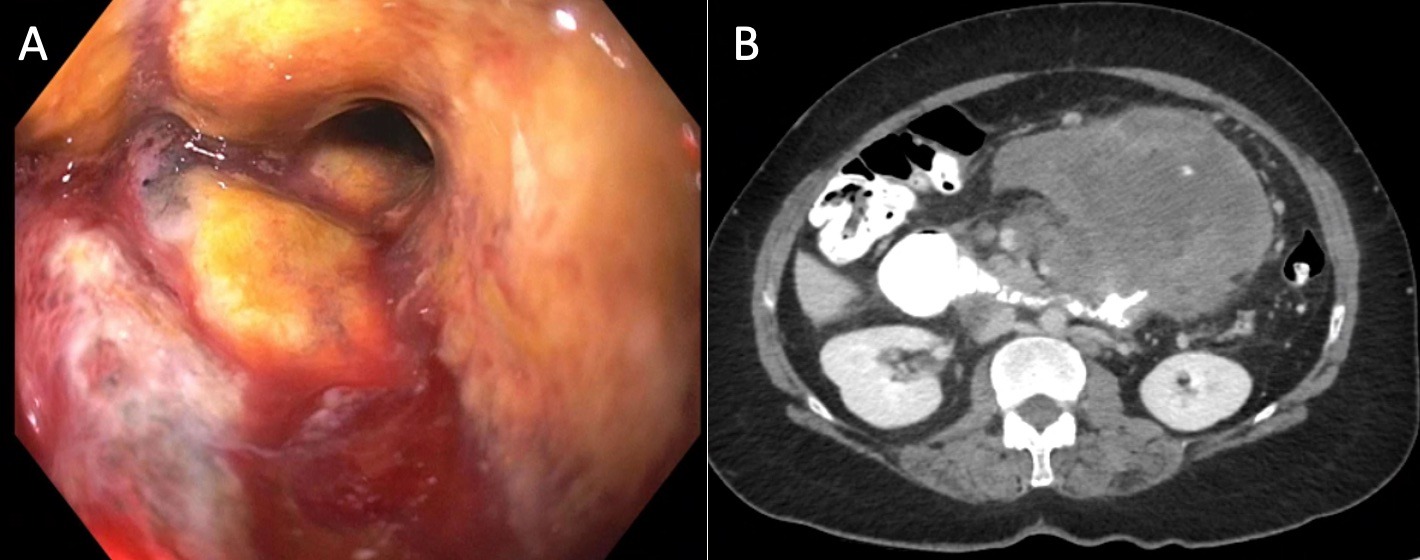Sunday Poster Session
Category: Small Intestine
P1327 - Peripheral Neuroectodermal Tumor Found in the Duodenum
Sunday, October 22, 2023
3:30 PM - 7:00 PM PT
Location: Exhibit Hall

Has Audio

Natalie Balassiano, MD
Icahn School of Medicine at Mount Sinai / NYC Health and Hospitals
Queens, NY
Presenting Author(s)
Award: Presidential Poster Award
Natalie Balassiano, MD1, Omar Asad, MD2, Anastasia Novikov, MD3
1Icahn School of Medicine at Mount Sinai / NYC Health and Hospitals, Queens, NY; 2University of Miami/HCA Florida JFK Medical Center, Atlantis, FL; 3Elmhurst Hospital Center/ Icahn School of Medicine at Mount Sinai, Elmhurst, NY
Introduction: Peripheral neuroectodermal tumors (PNET) are aggressive malignant neoplasms that typically occur in bone and soft tissues. They usually occur in children and adolescents between the ages of 10 and 20 with male predominance. However, duodenal involvement is exceptionally rare. Here we introduce a woman in her 5th decade presenting with a duodenal PNET.
Case Description/Methods: 56-year-old female with a past medical history of hypertension and CVA, presented with a 4 day onset of crampy abdominal pain associated with nausea and multiple episodes of non-biliary non-bloody emesis. She also complained of constipation for 2 weeks and inability to tolerate oral intake due to multiple episodes of vomiting. In the ED she presented with a heart rate of 120 bpm, and BP 80/50 mmHg. Workup was notable for leukocytosis of 15K, lactate 2.8 mmol/L. Patient had CT findings of proximal bowel obstruction with thickening of the 4th part of the duodenum and jejunum suspicious for lymphoma. A 5.2 cm adrenal incidentaloma was also noted. EGD revealed an obstructing circumferential duodenal mass concerning for malignancy. IR-guided biopsy of the duodenal mass and adrenal lesion revealed infiltrates of primitive round cell tumor consistent with a peripheral neuroectodermal tumor. She had 3 duodenal stents placed with a plan to initiate chemotherapy. Her hospitalization was complicated by a GI bleed and aspiration leading to respiratory failure. The patient subsequently passed.
Discussion: PNET’s presenting in the duodenum are exceedingly rare and only a limited number of cases have been reported in the medical literature, making it a diagnostic and therapeutic challenge. Duodenal PNETs pose diagnostic challenges due to their rarity and overlapping histological features with other gastrointestinal tumors. Accurate diagnosis often requires imaging, endoscopy, and histopathological evaluation. Treatment options for duodenal PNETs are not well established due to limited data. Multimodal therapy, including neoadjuvant or adjuvant chemotherapy, surgical resection, and radiation therapy are commonly considered. Duodenal PNETs generally have a poor prognosis, primarily attributed to the advanced stage at diagnosis and the aggressive nature of these tumors. This case illustrates the severity of duodenal PNETs and their associated complications, emphasizing the importance of early diagnosis and intervention. Long-term survival rates remain low, indicating the need for further research and advancements in treatment strategies.

Disclosures:
Natalie Balassiano, MD1, Omar Asad, MD2, Anastasia Novikov, MD3. P1327 - Peripheral Neuroectodermal Tumor Found in the Duodenum, ACG 2023 Annual Scientific Meeting Abstracts. Vancouver, BC, Canada: American College of Gastroenterology.
Natalie Balassiano, MD1, Omar Asad, MD2, Anastasia Novikov, MD3
1Icahn School of Medicine at Mount Sinai / NYC Health and Hospitals, Queens, NY; 2University of Miami/HCA Florida JFK Medical Center, Atlantis, FL; 3Elmhurst Hospital Center/ Icahn School of Medicine at Mount Sinai, Elmhurst, NY
Introduction: Peripheral neuroectodermal tumors (PNET) are aggressive malignant neoplasms that typically occur in bone and soft tissues. They usually occur in children and adolescents between the ages of 10 and 20 with male predominance. However, duodenal involvement is exceptionally rare. Here we introduce a woman in her 5th decade presenting with a duodenal PNET.
Case Description/Methods: 56-year-old female with a past medical history of hypertension and CVA, presented with a 4 day onset of crampy abdominal pain associated with nausea and multiple episodes of non-biliary non-bloody emesis. She also complained of constipation for 2 weeks and inability to tolerate oral intake due to multiple episodes of vomiting. In the ED she presented with a heart rate of 120 bpm, and BP 80/50 mmHg. Workup was notable for leukocytosis of 15K, lactate 2.8 mmol/L. Patient had CT findings of proximal bowel obstruction with thickening of the 4th part of the duodenum and jejunum suspicious for lymphoma. A 5.2 cm adrenal incidentaloma was also noted. EGD revealed an obstructing circumferential duodenal mass concerning for malignancy. IR-guided biopsy of the duodenal mass and adrenal lesion revealed infiltrates of primitive round cell tumor consistent with a peripheral neuroectodermal tumor. She had 3 duodenal stents placed with a plan to initiate chemotherapy. Her hospitalization was complicated by a GI bleed and aspiration leading to respiratory failure. The patient subsequently passed.
Discussion: PNET’s presenting in the duodenum are exceedingly rare and only a limited number of cases have been reported in the medical literature, making it a diagnostic and therapeutic challenge. Duodenal PNETs pose diagnostic challenges due to their rarity and overlapping histological features with other gastrointestinal tumors. Accurate diagnosis often requires imaging, endoscopy, and histopathological evaluation. Treatment options for duodenal PNETs are not well established due to limited data. Multimodal therapy, including neoadjuvant or adjuvant chemotherapy, surgical resection, and radiation therapy are commonly considered. Duodenal PNETs generally have a poor prognosis, primarily attributed to the advanced stage at diagnosis and the aggressive nature of these tumors. This case illustrates the severity of duodenal PNETs and their associated complications, emphasizing the importance of early diagnosis and intervention. Long-term survival rates remain low, indicating the need for further research and advancements in treatment strategies.

Figure: Image A is an EGD showing Intrinsic severe stenosis in the 4th portion of duodenum, malignant-appearing. Image B is a CT abdomen with contrast showing a large mid abdominal mass in duodenum.
Disclosures:
Natalie Balassiano indicated no relevant financial relationships.
Omar Asad indicated no relevant financial relationships.
Anastasia Novikov indicated no relevant financial relationships.
Natalie Balassiano, MD1, Omar Asad, MD2, Anastasia Novikov, MD3. P1327 - Peripheral Neuroectodermal Tumor Found in the Duodenum, ACG 2023 Annual Scientific Meeting Abstracts. Vancouver, BC, Canada: American College of Gastroenterology.

